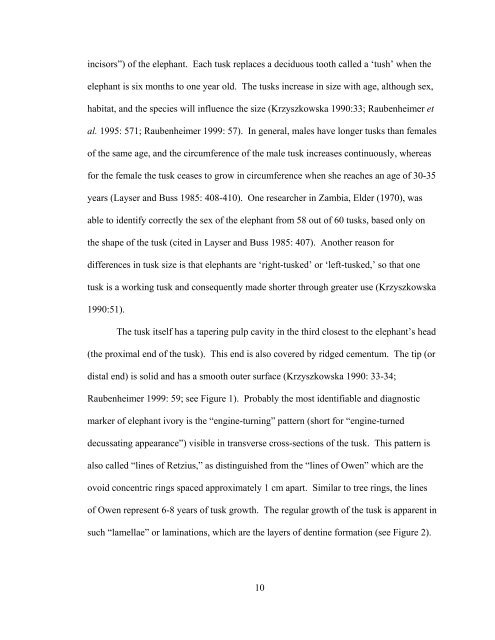Tracing the Source of the Elephant And Hippopotamus Ivory from ...
Tracing the Source of the Elephant And Hippopotamus Ivory from ...
Tracing the Source of the Elephant And Hippopotamus Ivory from ...
You also want an ePaper? Increase the reach of your titles
YUMPU automatically turns print PDFs into web optimized ePapers that Google loves.
incisors”) <strong>of</strong> <strong>the</strong> elephant. Each tusk replaces a deciduous tooth called a ‘tush’ when <strong>the</strong><br />
elephant is six months to one year old. The tusks increase in size with age, although sex,<br />
habitat, and <strong>the</strong> species will influence <strong>the</strong> size (Krzyszkowska 1990:33; Raubenheimer et<br />
al. 1995: 571; Raubenheimer 1999: 57). In general, males have longer tusks than females<br />
<strong>of</strong> <strong>the</strong> same age, and <strong>the</strong> circumference <strong>of</strong> <strong>the</strong> male tusk increases continuously, whereas<br />
for <strong>the</strong> female <strong>the</strong> tusk ceases to grow in circumference when she reaches an age <strong>of</strong> 30-35<br />
years (Layser and Buss 1985: 408-410). One researcher in Zambia, Elder (1970), was<br />
able to identify correctly <strong>the</strong> sex <strong>of</strong> <strong>the</strong> elephant <strong>from</strong> 58 out <strong>of</strong> 60 tusks, based only on<br />
<strong>the</strong> shape <strong>of</strong> <strong>the</strong> tusk (cited in Layser and Buss 1985: 407). Ano<strong>the</strong>r reason for<br />
differences in tusk size is that elephants are ‘right-tusked’ or ‘left-tusked,’ so that one<br />
tusk is a working tusk and consequently made shorter through greater use (Krzyszkowska<br />
1990:51).<br />
The tusk itself has a tapering pulp cavity in <strong>the</strong> third closest to <strong>the</strong> elephant’s head<br />
(<strong>the</strong> proximal end <strong>of</strong> <strong>the</strong> tusk). This end is also covered by ridged cementum. The tip (or<br />
distal end) is solid and has a smooth outer surface (Krzyszkowska 1990: 33-34;<br />
Raubenheimer 1999: 59; see Figure 1). Probably <strong>the</strong> most identifiable and diagnostic<br />
marker <strong>of</strong> elephant ivory is <strong>the</strong> “engine-turning” pattern (short for “engine-turned<br />
decussating appearance”) visible in transverse cross-sections <strong>of</strong> <strong>the</strong> tusk. This pattern is<br />
also called “lines <strong>of</strong> Retzius,” as distinguished <strong>from</strong> <strong>the</strong> “lines <strong>of</strong> Owen” which are <strong>the</strong><br />
ovoid concentric rings spaced approximately 1 cm apart. Similar to tree rings, <strong>the</strong> lines<br />
<strong>of</strong> Owen represent 6-8 years <strong>of</strong> tusk growth. The regular growth <strong>of</strong> <strong>the</strong> tusk is apparent in<br />
such “lamellae” or laminations, which are <strong>the</strong> layers <strong>of</strong> dentine formation (see Figure 2).<br />
10

















